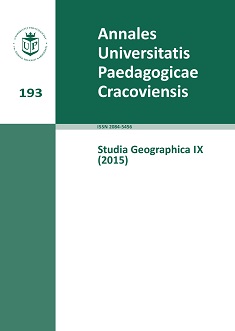Integrated public registers as a platform for building a Spatial Information System (SIS) in the Kuyavian-Pomeranian Voivodeship. Open source tools as means for building a regional Public Information System (PIS)
Keywords:
INSPIRE, open source GIS, PIS, SDIAbstract
The project called “Infostrada for Kuyavia and Pomerania” (where Infostrada stands for “Road to Information”) addresses the present day demand for Spatial Information Systems, which the administration authorities of the Kuyavian-Pomeranian Voivodeship intend to introduce in local government institutions. The System covers most of the voivodeship. The most important tool of the Kuyavian-Pomernian Spatial Information System (abbreviated to SIS) is ERGO software developed by Geopolis. Aided by the program, the local government institutions can access several dozens of registers and records grouped by themes in modules, under such headings as, for example, Environment Protection or Real Estate Management. With the help of the ERGO software it was possible to create the spatial point of reference for most of the data stored in registers and records. This georeferential system guarantees also the correct spatial presentation within the existing Spatial Information Systems. The nodes of the local government institutions in the project consist of the two subsystems: the back-office subsystem and the front-office subsystem. The back-office subsystem is a part of the ERGO package dedicated to the people authorized to running registers and records in the local government institutions. This subsystem allows, for example, to create the sequence of registers, each of them divided into modules. It also allows to create individual information databases or spatial information databases. With the help of the subsystem it’s also possible to design and archive individual documents as well as to verify the decisions taken so far or to carry out the spatial analyses. The introduction of the subsystems described in the institutions of local governments will help to solve the problems related to creating databases by people competent to do so as well as the problems resulting from a limited access to data by the persons from the outside. The front-office subsystem, on the other hand, has been designed with the external users in mind. The majority of registers and records constitutes public information that is run by the local government institutions. One of the chief assumptions of the Spatial Information System (PIS) is to make this very data from the registers and records public. In the case of ERGO software the data is made public with the aid of an external geoportal, the chief tool of the front-office subsystem. The geoportal contains the allocated theme maps that provide various types of spatial information, such as the local spatial development plans, accompanied by the alloted areas, as well as nature monuments (e.g. trees) or historical monuments.References
DYREKTYWA (2007). DYREKTYWA 2007/2/WE PARLAMENTU EUROPEJSKIEGO I RADY z dnia 14 marca 2007 r. ustanawiająca infrastrukturę informacji przestrzennej we Wspólnocie Europejskiej (INSPIRE). Dziennik Urzędowy Unii Europejskiej. L 108/1. PL.25.4.2007.
Gaździcki, J. (1990). Systemy Informacji Przestrzennej. Warszawa: Wyd. PPWK.
GEOPOLIS (2014). Opracowania własne, Toruń: GEOPOLIS Sp. z o.o.
Główny Urząd Statystyczny. Pozyskano z http://old.stat.gov.pl./gus/definicje_PLK_HTML.htm?id=POJ–5925.htm (z dn. 15.12.2014).
Litwin, L., Rossa, M. (2010). Metadane geoinformacyjne w INSPIRE i SDI. Zrozumieć. Edytować. Publikować. Gliwice: Wyd. ApropoGEO.
Olszewski, R., Gotlib, D. (red.). (2013). Rola bazy danych obiektów topograficznych w tworzeniu infrastruktury informacji przestrzennej w Polsce. Warszawa: Wyd. Główny Urząd Geodezji i Kartografii.
Opis Przedmiotu Zamówienia, 2013, Specyfikacja istotnych warunków zamówienia, 2013, Prace inwestycyjne oraz związane z procesem inwestycyjnym – budowa Systemu Informacji Przestrzennej wraz ze szkoleniami.
Parzyński, Z., Chojka, A. (2013). Infrastruktura Informacji Przestrzennej w UML. Warszawa: Wydawnictwo GEODETA.
Specyfikacja istotnych warunków zamówienia, 2013, Prace inwestycyjne oraz związane z procesem inwestycyjnym – budowa Systemu Informacji Przestrzennej wraz ze szkoleniami. Pozyskano z http://www.infostrada.kujawsko-pomorskie.pl/news.php?readmore=37. (z dn. 15.12.2015).
Targowski, A. (1980). Informatyka, Modele Systemów i Rozwoju. Warszawa: PWE.
www.infostrada.kujawsko-pomorskie.pl/articles.php?cat_id=4, 2014 (z dn. 15.12.2014)
www.kujawsko-pomorskie.pl/files/przetargi/ 20130828_przetarg_ 57/zal_3_2.pdf. (z dn. 15.12.2014).
Downloads
Published
Issue
Section
License
The submission of a paper to be published is synonymous with an agreement to transfer the copyright free of charge from the author to the publisher. The author also agrees to permit the publisher to publish the paper in printed form, open access online form, digital library form and other digital platforms with which the publisher has or will have a publishing agreement. Furthermore, the author agrees to not limit the number of copies that may be printed or issued by the publisher. In the case of co-authored papers, it is assumed that the corresponding author is authorized to represent the remaining co-authors in this respect. Authors are requested to sign a copyright declaration.

